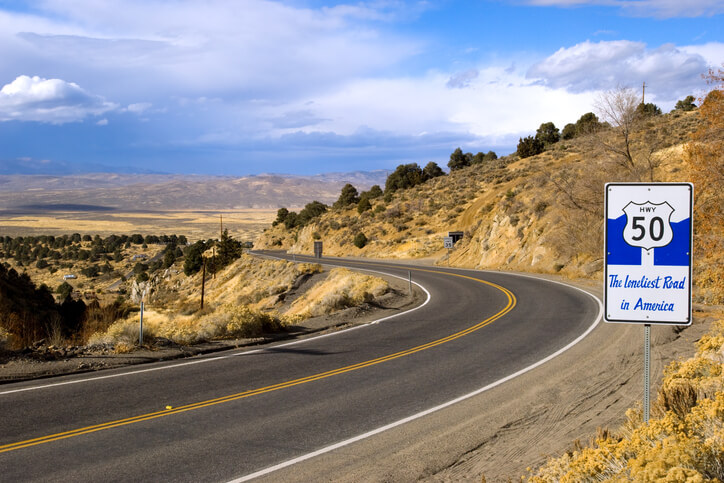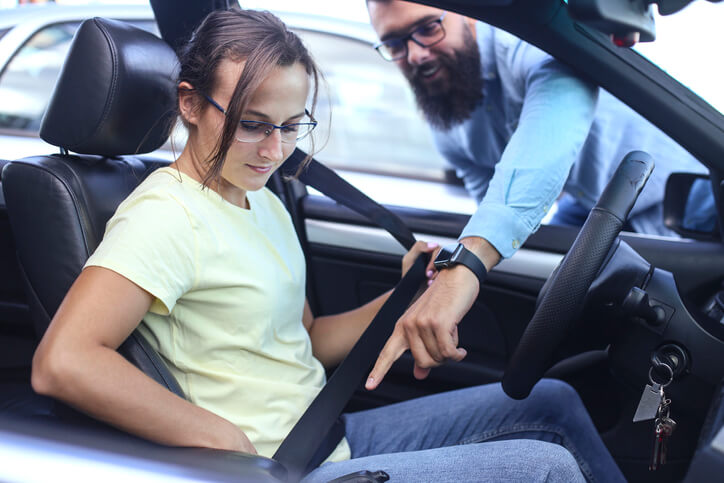Navigating the Silver State’s highways and byways can be a rewarding experience, especially when you know Nevada driving laws. But are you aware that trick driving is considered a reckless driving violation in Nevada? Or that you need to give at least three feet of space when passing bicyclists? With Nevada driving laws changing yearly, staying informed is crucial for your safety and others on the road.
- Start Here
- Traffic Safety Research
-
Top Driving Schools

-
Get Your Driver License

-
How to Get a License in Your State

- Alabama
- Alaska
- Arizona
- Arkansas
- California
- Colorado
- Connecticut
- Delaware
- District of Columbia
- Florida
- Georgia
- Hawaii
- Idaho
- Illinois
- Indiana
- Iowa
- Kansas
- Louisiana
- Maine
- Maryland
- Massachusetts
- Michigan
- Minnesota
- Mississippi
- Missouri
- Montana
- Nebraska
- Nevada
- New Hampshire
- New Jersey
- New Mexico
- New York
- North Carolina
- North Dakota
- Ohio
- Oklahoma
- Oregon
- Rhode Island
- South Carolina
- South Dakota
- Tennessee
- Texas
- Utah
- Vermont
- Virginia
- Washington
- West Virginia
- Wisconsin
- Wyoming
-
State Driving Laws

-
Permit Practice Tests

- Alabama
- Alaska
- Arizona
- Arkansas
- California
- Colorado
- Connecticut
- Delaware
- District of Columbia
- Florida
- Georgia
- Hawaii
- Idaho
- Illinois
- Indiana
- Iowa
- Kansas
- Louisiana
- Maine
- Maryland
- Massasschusetts
- Michigan
- Minnesota
- Mississippi
- Missouri
- Montana
- Nebraska
- Nevada
- New Hampshire
- New Jersey
- New Mexico
- New York
- North Carolina
- North Dakota
- Ohio
- Oklahoma
- Oregon
- Pennsylvania
- Rhode Island
- South Carolina
- South Dakota
- Tennessee
- Texas
- Utah
- Vermont
- Virginia
- Washington
- West Virginia
- Wisconsin
- Wyoming
-
DMV Handbooks

- Alabama
- Alaska
- Arizona
- Arkansas DMV Handbook
- California Driver’s Handbook
- Colorado
- Connecticut DMV Drivers Handbook
- Delaware
- District of Columbia
- Florida
- Georgia
- Hawaii
- Idaho Driver’s Handbook
- Illinois
- Indiana
- Iowa
- Kansas
- Louisiana
- Maine
- Maryland
- Massachusetts
- Michigan
- Minnesota
- Mississippi
- Missouri
- Montana DMV Drivers Handbook
- Nebraska
- Nevada
- New Hampshire
- New Jersey
- New Mexico
- New York
- North Carolina
- North Dakota
- Ohio
- Oklahoma DMV Handbook Drivers Manual
- Oregon
- Rhode Island
- South Carolina
- South Dakota
- Tennessee DMV Driver’s Handbook
- Texas
- Utah
- Vermont
- Virginia
- Washington
- West Virginia
- Wisconsin
- Wyoming
-
Find Online Driver’s Ed

- Find a Driving School
-
How to Get a License in Your State
-
What is S.P.I.D.E.R?

- Traffic Safety Research
-
Top Driving Schools

-
Get Your Driver License

-
How to Get a License in Your State

- Alabama
- Alaska
- Arizona
- Arkansas
- California
- Colorado
- Connecticut
- Delaware
- District of Columbia
- Florida
- Georgia
- Hawaii
- Idaho
- Illinois
- Indiana
- Iowa
- Kansas
- Louisiana
- Maine
- Maryland
- Massachusetts
- Michigan
- Minnesota
- Mississippi
- Missouri
- Montana
- Nebraska
- Nevada
- New Hampshire
- New Jersey
- New Mexico
- New York
- North Carolina
- North Dakota
- Ohio
- Oklahoma
- Oregon
- Pennsylvania
- Rhode Island
- South Carolina
- South Dakota
- Tennessee
- Texas
- Utah
- Vermont
- Virginia
- Washington
- West Virginia
- Wisconsin
- Wyoming
-
State Driving Laws

-
Permit Practice Tests

- Alabama
- Alaska
- Arizona
- Arkansas
- California
- Colorado
- Connecticut
- Delaware
- District of Columbia
- Florida
- Georgia
- Hawaii
- Idaho
- Illinois
- Indiana
- Iowa
- Kansas
- Louisiana
- Maine
- Maryland
- Massasschusetts
- Michigan
- Minnesota
- Mississippi
- Missouri
- Montana
- Nebraska
- Nevada
- New Hampshire
- New Jersey
- New Mexico
- New York
- North Carolina
- North Dakota
- Ohio
- Oklahoma
- Oregon
- Pennsylvania
- Rhode Island
- South Carolina
- South Dakota
- Tennessee
- Texas
- Utah
- Vermont
- Virginia
- Washington
- West Virginia
- Wisconsin
- Wyoming
-
DMV Handbooks

- Alabama
- Alaska
- Arizona
- Arkansas DMV Handbook
- California Driver’s Handbook
- Colorado
- Connecticut DMV Drivers Handbook
- Delaware
- District of Columbia
- Florida
- Georgia
- Hawaii
- Idaho Driver’s Handbook
- Illinois
- Indiana
- Iowa
- Kansas
- Louisiana
- Maine
- Maryland
- Massachusetts
- Michigan
- Minnesota
- Mississippi
- Missouri
- Montana DMV Drivers Handbook
- Nebraska
- Nevada
- New Hampshire
- New Jersey
- New Mexico
- New York
- North Carolina
- North Dakota
- Ohio
- Oklahoma DMV Handbook Drivers Manual
- Oregon
- Pennsylvania
- Rhode Island
- South Carolina
- South Dakota
- Tennessee DMV Driver’s Handbook
- Texas
- Utah
- Vermont
- Virginia
- Washington
- West Virginia
- Wisconsin
- Wyoming
-
Find Online Driver’s Ed

- Find a Driving School
-
How to Get a License in Your State
-
What is S.P.I.D.E.R?









